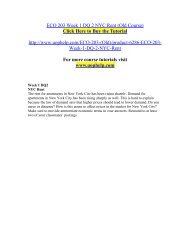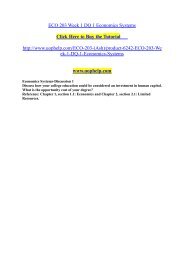ECET 370 Week 7 Lab 7 Binary Trees.pdf
For more course tutorials visit www.uophelp.com Full set of lab with working programs. Exercise 1: Lecture review: Binary Search Tree Create a project using the classes Binary Search Tree, Node, and Main in the DocSharing area labeled “The BST." Compile the project, run it, and review the code that is given carefully. These programs test the code discussed in our lecture. Exercise 2: An improved BST class Modify the class Binary Search Tree so that it contains the to String method, instead of the display method that was given originally. Exercise 3: Using a BST in an application Use a binary search tree to implement a dictionary that contains the keywords in the Java language. Test it. Note that you can use the programs from the previous exercises. For a list of the keywords in Java, visit http://java.sun.com/docs/books/tutorial/java/nutsandbolts/_keywords.html. Exercise 4: Recursion and Binary Trees Write a recursive algorithm that counts the nodes in a binary search tree. Exercise 5: Using properties of BSTs Write an algorithm get Max to find the maximum value stored in a binary search tree.
For more course tutorials visit
www.uophelp.com
Full set of lab with working programs.
Exercise 1: Lecture review: Binary Search Tree Create a project using the classes Binary Search Tree, Node, and Main in the DocSharing area labeled “The BST." Compile the project, run it, and review the code that is given carefully. These programs test the code discussed in our lecture.
Exercise 2: An improved BST class Modify the class Binary Search Tree so that it contains the to String method, instead of the display method that was given originally.
Exercise 3: Using a BST in an application Use a binary search tree to implement a dictionary that contains the keywords in the Java language. Test it. Note that you can use the programs from the previous exercises. For a list of the keywords in Java, visit http://java.sun.com/docs/books/tutorial/java/nutsandbolts/_keywords.html.
Exercise 4: Recursion and Binary Trees Write a recursive algorithm that counts the nodes in a binary search tree.
Exercise 5: Using properties of BSTs Write an algorithm get Max to find the maximum value stored in a binary search tree.
Create successful ePaper yourself
Turn your PDF publications into a flip-book with our unique Google optimized e-Paper software.
<strong>ECET</strong> <strong>370</strong> <strong>Week</strong> 7 <strong>Lab</strong> 7 <strong>Binary</strong> <strong>Trees</strong> (Devry)Click Here To Buy The Tutorialhttp://www.uophelp.com/<strong>ECET</strong>-<strong>370</strong>-(Devry)/product-9174-<strong>ECET</strong>-<strong>370</strong>-<strong>Week</strong>-7-<strong>Lab</strong>-7-<strong>Binary</strong>-<strong>Trees</strong>-(Devry)For more course tutorials visitwww.uophelp.comFull set of lab with working programs.Exercise 1: Lecture review: <strong>Binary</strong> Search Tree Create a project using the classes <strong>Binary</strong> SearchTree, Node, and Main in the DocSharing area labeled “The BST." Compile the project, run it,and review the code that is given carefully. These programs test the code discussed in our lecture.Exercise 2: An improved BST class Modify the class <strong>Binary</strong> Search Tree so that it contains theto String method, instead of the display method that was given originally.Exercise 3: Using a BST in an application Use a binary search tree to implement a dictionary thatcontains the keywords in the Java language. Test it. Note that you can use the programs from theprevious exercises. For a list of the keywords in Java, visithttp://java.sun.com/docs/books/tutorial/java/nutsandbolts/_keywords.html.Exercise 4: Recursion and <strong>Binary</strong> <strong>Trees</strong> Write a recursive algorithm that counts the nodes in abinary search tree.Exercise 5: Using properties of BSTs Write an algorithm get Max to find the maximum valuestored in a binary search tree.

















